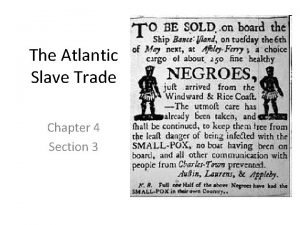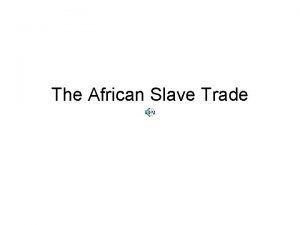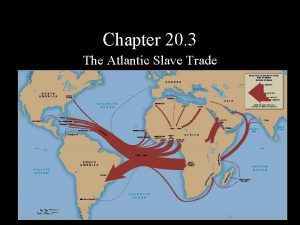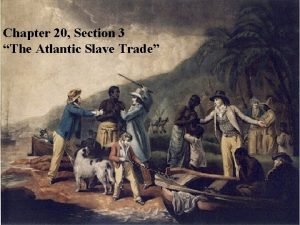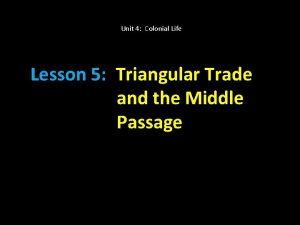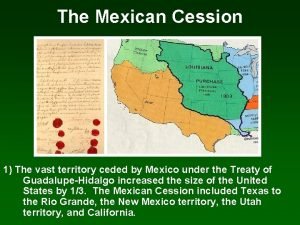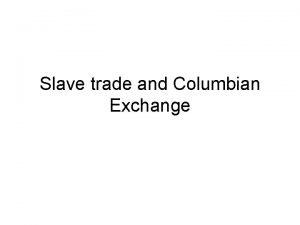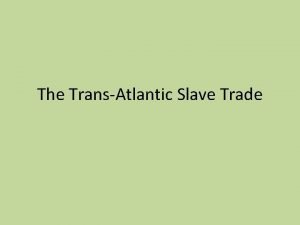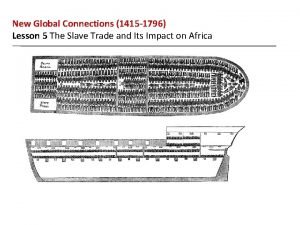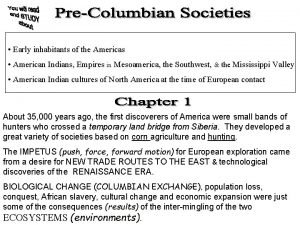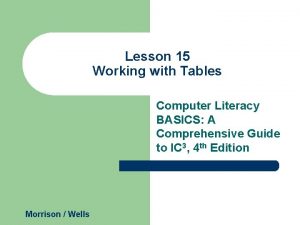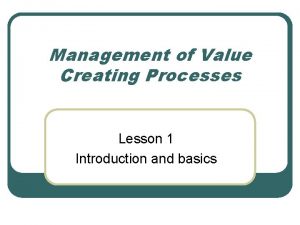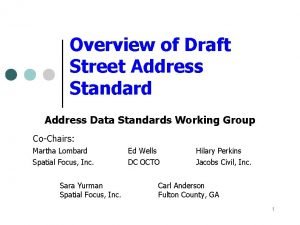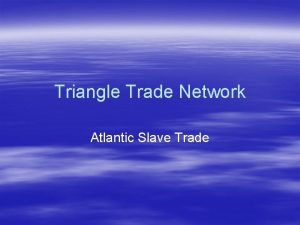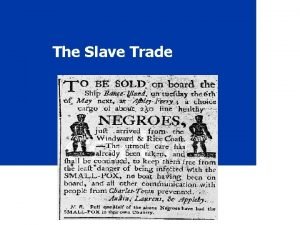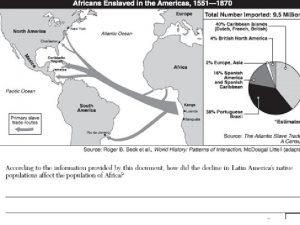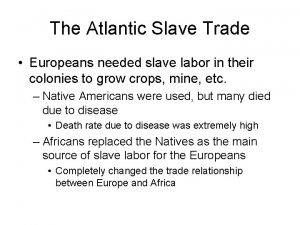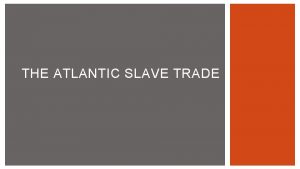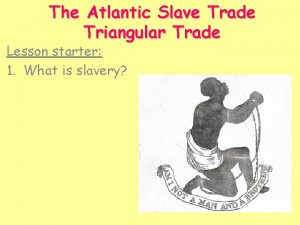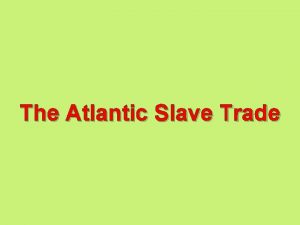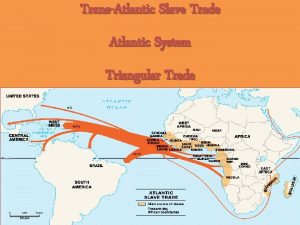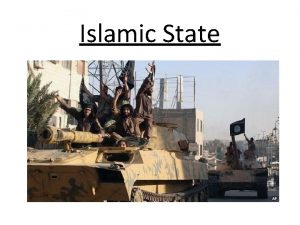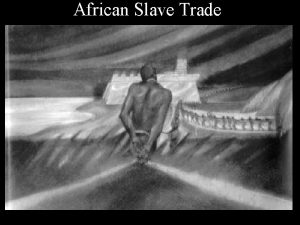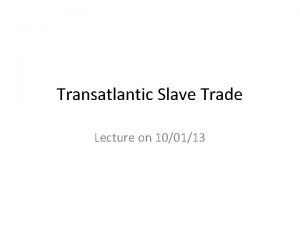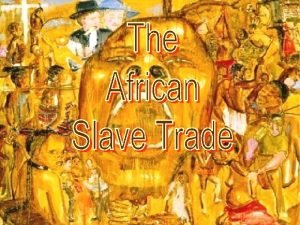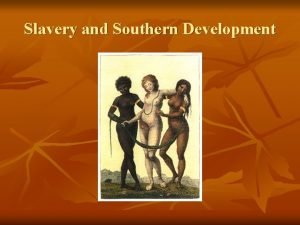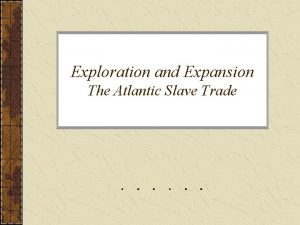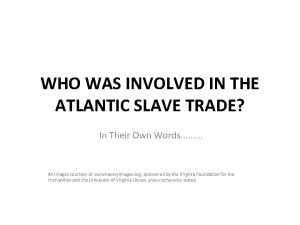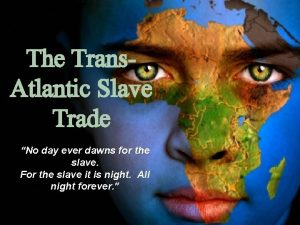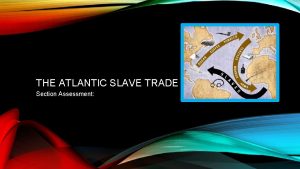Atlantic Slave Trade Continued 031013 Islamic Slave Trade








































- Slides: 40

Atlantic Slave Trade (Continued) 03/10/13

Islamic Slave Trade? A misnomer? • If transatlantic trade has not been called “Christian slave trade”, then it would be more appropriate to use Arab/Persian slave trade instead of Islamic slave trade.

What is triangular Trade?

Triangular Trade • The Atlantic trade route (trade of slaves, sugar and manufactured goods) between Europe, Africa, and the Americas formed a triangular pattern.

Process of making slaves (p. 426) • Brutal and inhumane business. • As the demands for slaves grew, African chieftains organized attacks and wars on neighboring societies for capturing individuals. • Individuals were taken from homes and fields. • Captives were taken to the coast to live in holding pins until the ship arrived to take them.

African Captives in Yokes

Middle Passage • Harsh conditions on the ship--Filthy, crowded, cramped quarters. • Inhumane and cruel treatment of slaves. • Travel time (4 to 6 weeks). • High death rate among slaves due to disease (half of them would die in early days).

The Impact of the Slave Trade in Africa • High volume of slaves exported to Americas (average 55, 000/year). • About 12 million African brought to the Americas and about 4 million died before arriving.

The Impact of the Slave Trade in Africa • The impact varied over time and from one society to another. • Some African societies (Asante, Dahomey and Oyo) profited from slave trade (got fire arms) and built powerful states in west Africa. • Societies close to the port had to bear huge losses and were extremely vulnerable to slaver trade.

The Impact of the Slave Trade in Africa • Overall, the impact of slave trade on Africa was devastating. a) 16 million African people taken away b) Imbalance in male-female sex ratio---male slaves (ages 14 -35 highly preferred). By late 18 th century women made up 2/3 rds of the society. • Social implications i) Polygamy ii) Increased workload for women (they had to men’s jobs too).

Political Implications • Violence increased as result of increasingly exchanged slaves for firearms. • The kingdom with more firearms would attack and capture slaves from neighboring societies. • (for example: kingdom of Dahomey on P. 428).

African Diaspora Slaves did resist bondage (slavery) in their own way and often created hybrid cultures (mixture of African, European, and American cultures).

Plantations Societies WORK: Slaves worked as urban workers, domestic servants and miners, but mostly as agricultural labors on plantations. Plantation regions: Spanish colonies------Haiti, the Dominican Republic, and Mexico Portuguese colony-----Brazil English, Dutch, and French colonies-----Caribbean and the Americas

Plantations Societies South American and Caribbean • received a very high number of slaves, these places still needed continuous supply of slaves from Africa. • Reasons: a) Tropical diseases killed many. b) More male slaves few females (slow reproduction) North American • Only 5% of slaves went to North American destination but they were able to increase their numbers. • Reasons: • and less threatening diseases • higher number of female slaves.

Resistance to Slavery • Slaves did not meekly accepted their status but showed resistance in various ways. Examples: a) Worked slowly on plantations. b) Sabotaged plantation equipment or routine. c) Running away----some even formed societies (see Maroon societies p. 429).

Maroon Societies • Runaway slaves made their own selfgoverning societies in remote areas throughout north America. • Many Maroons had gained military training in Africa and organized escaped slaves into effective military forces.

Resistance to Slavery d) Revolt: • Rising up against the owners ---most dramatic form of resistance. • but it never ended slavery, because ruling elites would use military force against them. One exception: revolt in French sugar colony of Saint-Dominigue ended slavery was renamed HAITI.

Slavery and Economic Development in Americas • The physical labor of African slaves made significant contribution to societies in the Americas. • Cultivated crops. • Extracted minerals. • Resulting in global trade of early modern era. Unfortunately, the very people responsible for this development remained deprived for a long time.

Racist Attitudes against blacks • Stereotypes and racist attitudes (the belief that blacks are inferior than whites) is a result of transatlantic slave trade.

The Making of African American Cultural Traditions • African slaves did not have the liberty to continue to practice their culture freely in western hemisphere. • Also, on ships the slaves met with others from different African societies. • In the Americas and Caribbean the slaves lived in societies shaped by European and American traditions. • As a result they constructed a distinctive African. American cultural tradition.

Language • Slaves often spoke Creole tongue that drew upon several African and European languages.

African- American Religions • Slaves’ religion also combined elements from different societies (African, European, native American). • Most Africans practiced a syncretic faith (mixing of different religions) that allowed them to make use of African interests and traditions.

Influence of Christianity • All syncretic religions drew inspiration from Christianity. • Some examples: • Meeting in churches, sought personal salvation. • Made use of Christian paraphernalia (different items used in Christianity) such as candles, holy water, statues.

Influence of African traditions on Christianity • Slaves continued to use African rituals and these practices played prominent roles in in African American religions. • For example: • Drumming, dancing, sacrificing animals. • Beliefs in spirits, supernatural powers, magic, witchcraft and spirit possession

Example of some African American Religions. • Examples: Vodou in Haiti, Santeria in Cuba, and Candomble in Brazil.

Candomble in Brazil • http: //www. youtube. com/watch? v=dr 3 z. QRXz uv. Y

example • Vodou: a set of spiritual folkways which originated from the traditions of the African diaspora. http: //www. youtube. com/watch? v=xe. V 17 m 4 Vi 4

Also, • African American churches improvised on some Christian traditions such as church music.

Black Gospel Music • http: //www. youtube. com/watch? v=ntujs. GAp w. T 0

African American Cultural Traditions a) Food • Slaves introduced African foods to Caribbean. • GUMBO is a good example of combining African (okra), European styles sautéed vegetables, and American shellfish. b) The slaves also introduced rice cultivation. c) Crafts: clay pots, baskets.

The End of Slave Trade and the Abolition of Slavery • Abolitionism or Abolitionist movement: The goal of the movement was to end slave trade and to free the slaves. French and American revolutions (with their emphasis on liberty) stimulated Abolitionist movement.

Olaudah Equiano • Was a slave who later gained freedom. • Wrote an autobiography about harch brutalities of slavery and the book became a best seller. • He travelled throughout the Europe, gave speeches and lobbied for abolition of slavery.

Economic costs of slavery NOTE: In addition to socio/political reasons, there were some important economic reasons for abolition of slaver trade/slavery.

Economic costs of Slavery • The slave trade was becoming expensive. • Military forces were needed to prevent rebellion in slave societies. • African slave traders and European merchants shapely increased their prices. • The focus of trade shifted from plantations to manufacturing factories (more profitable).

Important • End of Slave Trade did not end slavery did not end immediately. • Slavery as an institution it self was a long drawn out process. • See dates on p. 431 -432 for end of slave trade and end of slavery.

Quiz 2 On Thursday October 19 th • • 8 points 4 -5 short questions and answers (4 -6 lines). Over Transatlantic Slave Trade Prepare the following questions for the quiz.

Questions for quiz on Thursday Oct 10 th • What is meant by middle passage? • Explain the kind of treatment the slaves received on the ships. • What was transatlantic slave trade called “the triangular trade”? • List some social and political implications of slavery for Africa? • What are cash crops? What were some important cash crops grown on plantations?

Questions for quiz on Thursday Oct 10 th • How did Christianity influence African religions? • How did slaves resist slavery? Give at least two examples. • What were some economic reasons for end of slave trade?

Next class • Will discuss common writing assignment

Quizzes • Hand back graded quiz 1 Important: The quiz with lowest grade will be dropped/ will not be counted. Example:
 Chapter 4 section 3 the atlantic slave trade
Chapter 4 section 3 the atlantic slave trade The age of exploration outcome the atlantic slave trade
The age of exploration outcome the atlantic slave trade Triangular trade
Triangular trade Atlantic slave trade
Atlantic slave trade Chapter 20 section 3 the atlantic slave trade
Chapter 20 section 3 the atlantic slave trade Chapter 20 section 3 the atlantic slave trade
Chapter 20 section 3 the atlantic slave trade The age of exploration outcome the atlantic slave trade
The age of exploration outcome the atlantic slave trade Slave trade primary sources
Slave trade primary sources Transatlantic trade apush
Transatlantic trade apush The transatlantic question
The transatlantic question Slave trade triangle
Slave trade triangle Washington dc slave trade
Washington dc slave trade The transatlantic slave trade
The transatlantic slave trade Transatlantic slave trade pictures
Transatlantic slave trade pictures Lesson 5 the slave trade and its impact on africa
Lesson 5 the slave trade and its impact on africa What god
What god Table continued
Table continued I ll look like if looking liking move
I ll look like if looking liking move Continued
Continued Part 4 forms of energy continued
Part 4 forms of energy continued Older television sets had tubes
Older television sets had tubes Indirect object pronouns (continued)
Indirect object pronouns (continued) Capítulo 4a indirect object pronouns (continued answers)
Capítulo 4a indirect object pronouns (continued answers) Continued on next slide
Continued on next slide To be continued
To be continued Zco verbs
Zco verbs Section 1 atmospheric basics continued answers
Section 1 atmospheric basics continued answers Factoring special products examples
Factoring special products examples Continued abbreviation
Continued abbreviation Section 3 cellular respiration continued
Section 3 cellular respiration continued To be continued
To be continued We can wait here until carlo calls us
We can wait here until carlo calls us Complete the square activity
Complete the square activity Compound adjectives list
Compound adjectives list Position cost distribution
Position cost distribution Continued from
Continued from References continued apa
References continued apa Address continued
Address continued Completion of squares
Completion of squares Colons
Colons Romeo climbs over the wall
Romeo climbs over the wall
